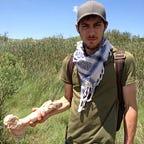Photogrammetry of the Baby Mammoth Bronze at the Lubbock Lake Landmark
The Columbian mammoth was one of the largest Pleistocene mammals on the North American continent ~11,000 years ago. These megafauna were hunted by the earliest Americans and are present in the archaeological record. One such area where these Pleistocene fossils have been found is the Lubbock Lake Landmark. Constructed to their real life size outside of the Landmark’s Interpretative Center they have five bronze statues of the Pleistocene mammals that roamed this landscape in the past. The bronzes include a Bison antiquus, the Short-Faced bear, two Columbian mammoths and a giant Armadillo)
To start this process I began by choosing one of the large bronze statues to photograph and try to render it as a three dimensional model. I chose the baby mammoth statue because having done this process before I felt that the baby mammoth statue would be a challenge.
Method
I took 57 photos of the mammoth with my iPhone 6s which has an autofocus 29mm lens, 12 Megapixel Camera with a fixed f stop setting of 2.2 on the aperture.
I captured all of my photos starting at approximately 3:15 pm on Friday September 9th. The weather conditions were clear and sunny which made it ideal for collecting photos for photogrammetry.
I made three complete circles around the baby mammoth making sure that the photos that I was taking overlapped at three different heights for complete coverage. The largest source of error that I encountered at this stage came from the proximity of the large mammoth statue to the baby mammoth which resulted in a slight “jump” between the photos I captured from the front of the statue to the front left side of the statue on the wider shots of the overall statue. Another source of error came from the back left side of the statue being in almost complete shade from the larger mammoth statue.
I used Photoshop to mask all of the photos to isolate the baby mammoth from the surrounding background landscape. To use the Photoshop masking I needed to convert the Jpeg image files into Tiff files so that they would have the Alpha channels necessary for Agisoft Photoscan to import the masks.
Once I had all of the images converted into Tiff files I started the arduous task of manually masking all 57 of the photos that I took of the statue which was somewhat difficult and time consuming, most likely because of the conversion from Jpeg images to Tiff images and the unavoidable quality loss that resulted from this process. Overall masking of all of the images that I shot took me about 3 hours total.
Once I had all of the images masked I was able to move over to Photoscan and try to align all of the photos. After adding the photos into the program and importing the masks, I initially tried to align the photos on the highest settings with relatively great success with about 2/3 of the model coming out almost perfect and the remainder of the model being misaligned or absent. I continued to run the model creating the dense cloud at the highest settings, then making a mesh with the highest face count and then the texture. However when I tried to upload the model to Sketchfab online the file size was too large and I had to scrap the whole model. A solid waste of several hours.
When I tried to realign the photos on high alignment settings instead of Ultra High I found that the model had more sections covered although slightly less aligned but overall more complete. I tried to align the photos on both medium and low settings to see if I could create a complete image but as I lowered the photo alignment parameters the images became less complete, so I decided to stick with the High alignment of the photos and build the dense cloud from that alignment.
I built the dense cloud at high settings and was successful in full coverage of the right side, front and back of the statue however the left side of the model was fairly incomplete with about half of the side missing from the model. As I predicted the heavily shaded portions of the statue were the sections that the Agisoft Photoscan had the most trouble aligning and was unable to create a solid dense cloud.
I decided to continue on with the creating the mesh and the texture for the model from this point trying to build the model with both a medium face count mesh and a high face count mesh. I decided not to try and fill the gaps using the close holes tool on Photoscan because it connected points that should not have been connected and made the model a mangled mess.
I uploaded both models to Sketchfab but for obvious reasons the model with the higher face count mesh produced better results. I’ve linked both models below.
Medium Quality Model on Sketchfab
High Quality Model on Sketchfab
Overall the model came out mostly as a success. The bronze statue itself posed a decent challenge and the issues that I had creating the model I believe are a problem with the baby mammoth positioning in proximity to the mother mammoth statue. The lighting itself was impacted by the larger mammoth. So unless the sun was directly overhead I don’t think that it would be possible to get good lighting on the statue, but that would make it more difficult to photograph the bottom of the statue. The only acceptable solution that I could come up with to this problem would be to return and take photos of the statue at several different times of the day to optimize the lighting on different sections of the statue.
